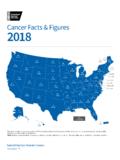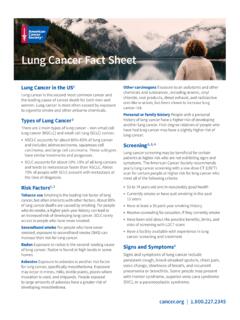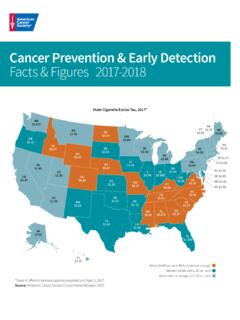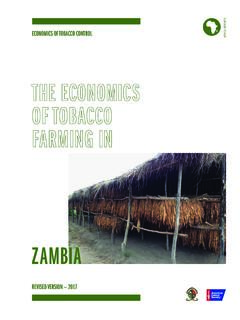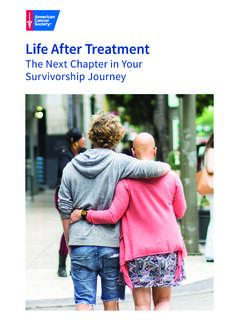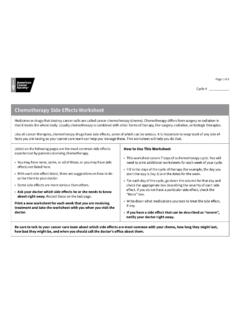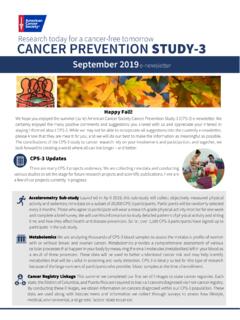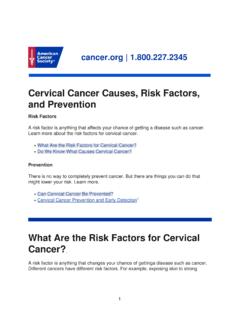Transcription of Cancer Facts & Figures for African Americans 2019-2021
1 Cancer Facts & Figures for African Americans 2019 -2021. Contents Cancer Statistics 1 Figure 7. Adult Cigarette Smoking Prevalence (%) by Sex and Race, US, 1965-2017 20. Figure 1. Non-Hispanic Black population as a Percentage of Total County population , 2016 1. Risk Factors for Cancer 20. Table 1. Leading Causes of Death by Sex among Figure 8. Current Cigarette Smoking Prevalence (%). Non-Hispanic Blacks and Whites, US, 2016 2. by Sex and Race/Ethnicity, US, 2017 21. Table 2. Lifetime Probability of Developing or Dying from Table 7. Excess Body Weight Prevalence (%), Youth Invasive Cancers by Race and Sex, US, 2013-2015 3.
2 And Adults, US, 2015-16 22. Figure 2. Leading Sites of New Cancer Cases and Deaths Figure 9. trends in Obesity Prevalence (%), Adults 20-74. among Blacks in the US 2019 Estimates 4. Years, by Sex and Race/Ethnicity, US 1976-2016 22. Table 3. Incidence Rates for Selected Cancers in Non- Figure 10. Prevalence of Obesity (%), Adults 18 years Hispanic Blacks by Sex and State, 2011-2015 5. and Older, 2015-2017 24. Table 4. Death Rates for Selected Cancers in Non- Table 8. Physical Inactivity Prevalence (%), Adults and Hispanic Blacks by Sex and State, 2012-2016 6. High School Students, by Sex and Race/Ethnicity, US, 2017 26.
3 Figure 3. trends in Death Rates for Selected Cancer Sites among Blacks and Whites, US, 1975-2016 7 Cancer Screening 28. Table 5. Comparison of Cancer Incidence Rates between Table 9. Prevalence (%) of HPV Vaccination (2017) and Non-Hispanic (NH) Blacks and Whites, US, 2011-2015 8 Cancer Screening (2015), US 29. Table 6. Comparison of Cancer Death Rates between Non-Hispanic (NH) Blacks and Whites, US, 2012-2016 9 Factors That Influence Health 30. Figure 4. Stage Distribution for Selected Cancers in How the american Cancer Society Helps Non-Hispanic (NH) Blacks and Whites, US, 2008-2014 10 Reduce Cancer Disparities 31.
4 Figure 5. Five-year Relative Survival Rates for Selected Cancers by Race and Stage, US, 2008-2014 11 Additional Resources 34. Selected Cancers 12 Sources of Statistics 34. Figure 6. trends in Incidence Rates (1975-2015) and Death References 36. Rates (1975-2016) among Blacks for Selected Cancers by Sex 13. Global Headquarters: american Cancer Society Inc. 250 Williams Street, NW, Atlanta, GA 30303-1002. This publication attempts to summarize current scientific information about Cancer . 404-320-3333. 2019 , american Cancer Society, Inc. All rights reserved, Except when specified, it does not represent the official policy of the american Cancer Society.
5 Including the right to reproduce this publication or portions thereof in any form. Suggested citation: american Cancer Society. Cancer Facts & Figures for African Americans 2019 -2021. For written permission, address the Legal department of the american Cancer Society, 250 Williams Street, NW, Atlanta: american Cancer Society, 2019 . Atlanta, GA 30303-1002. the US is primarily concentrated in the South (Figure 1). It is Cancer Statistics a diverse group that includes individuals whose ancestors were brought to the US as slaves, as well as nearly 10% who are more recent immigrants or their descendants.
6 The Introduction black immigrant population has increased five-fold over The US Census Bureau estimates that in 2017 there were the past four decades, from 816,000 in 1980 to more than million Americans who identified as non-Hispanic million in 2017. Approximately half of these immigrants (NH) black or African american , comprising 13% of the were born in Carribean countries, including Jamaica (18%). total US Although racial classification is a and Haiti (17%) and about 38% were from African countries social construct, it remains useful for describing general (7% from Nigeria).3 Previous studies have documented patterns of health because much data in the US are differences in the Cancer profile for blacks born outside of reported by race.
7 In addition, some Cancer -associated the US compared to US-born blacks, including notably genetic mutations are more common among certain lower rates for smoking-related , 5. genetic ancestry groups, for which self-identified race can be used as a proxy. In this report, data are presented for Collectively, blacks have the highest death rate and NH blacks specifically when available. shortest survival of any racial/ethnic group in the US for most cancers. Black men also have the highest Cancer Blacks are the second-largest racial/ethnic minority group incidence rate. The causes of these inequalities are in the US, following Hispanics.
8 It is projected that by 2060, complex and reflect social and economic disparities and there will be million blacks living in the US, making cultural differences that affect Cancer risk, as well as up 15% of the total The black population in Figure 1. Non-Hispanic Black population as a Percentage of Total County population , 2016. Percent or more to to to Less than . Source: US Census Bureau, population Estimates, July 1, 2016. Released 2017. 2019 , american Cancer Society, Inc., Surveillance Research Cancer Facts & Figures for African Americans 2019 -2021 1. Table 1. Leading Causes of Death by Sex among Non-Hispanic Blacks and Whites, US, 2016.
9 Males NH Black NH White Cause of Death Rank Number % Death Rate* Rank Number % Death Rate*. Heart diseases 1 40,040 24% 1 266,981 25% Cancer 2 35,215 21% 2 247,202 23% Accidents (unintentional injuries) 3 12,452 7% 3 76,025 7% Cerebrovascular diseases 4 8,114 5% 5 43,711 4% Diabetes 5 6,976 4% 6 30,010 3% All causes 168,742 1,077,329 Females NH Black NH White Cause of Death Rank Number % Death Rate* Rank Number % Death Rate*. Heart diseases 1 36,563 23% 1 233,632 22% Cancer 2 34,510 22% 2 219,262 21% Cerebrovascular diseases 3 10,074 6% 5 63,776 6% Diabetes 4 7,077 4% 7 23,389 2% Alzheimers 5 6,126 4% 4 67,893 6% All causes 158,057 1,056,078 NH: Non-Hispanic.
10 *Rates are per 100,000 and age adjusted to the 2000 US standard population . Source: National Center for Health Statistics, Centers for Disease Control and Prevention. 2019 , american Cancer Society, Inc., Surveillance Research differences in access to high-quality health care, more What Is Cancer ? than biological differences. Socioeconomic disparities Cancer is a group of diseases characterized by result in unequal access to opportunities and resources, uncontrolled growth and spread of abnormal cells. If the such as work, wealth, income, education, housing, spread is not controlled, it can result in death.
